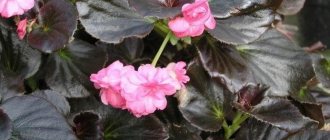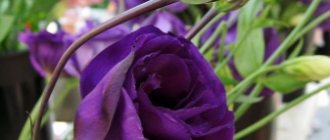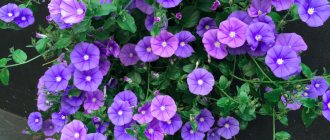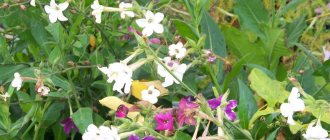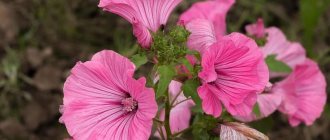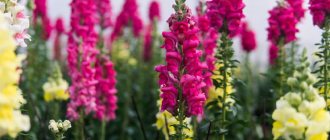Cobaea liana is a climbing subshrub that is an annual and belongs to the cyanaceae family. Gardeners cultivate it as an annual plant. This vine was named after Barnabas Cobo, who was a naturalist monk who lived in the homeland of this plant (Peru and Mexico) for several years. In nature, kobeya can be found in tropical and subtropical rainforests of North and South America. This plant has been cultivated since 1787, and it is most often used for vertical gardening of gazebos or hedges.
Description of Kobei
Kobeya is an ornamental vine. Its homeland is Mexico and Peru, where it blooms almost all year round as a perennial and serves as decoration for facades and gazebos. In Russia, the flower is considered an annual, since it is not able to survive the winter even in the southern regions, unless we are talking about greenhouse cultivation.
In our country, only one variety of kobei has taken root - climbing.
Under favorable conditions, its shoots can reach 7 meters in length, but the average is 4 meters. Leaves are oval shaped. In summer they are green, but when it gets colder they change color to red-violet. Therefore, even in the absence of flowering, kobeya looks quite attractive at the end of the season.
In mid-summer, cup-shaped buds appear on the vine. Their diameter is 7-8 cm. The color of the petals can be white, lilac (purple) or pink. After flowering is completed, green, egg-shaped fruits are formed.
Interesting! Experienced flower growers note that white kobeya is the most capricious variety of flower.
In some growing regions it is not possible to wait for them, since frosts occur quite early.
Cobaea species
There are 9 known species of Cobaea; in our regions only one, climbing or creeping Cobaea (Cobaea scandens), is cultivated. In our stores you can buy Kobei seeds with flowers of different colors: blue, white, lilac, purple. White Cobaea is a subspecies of the tenacious Cobaea.
It is not easy to grow a liana in mid-latitudes, but Creeping Kobeya can become a real beauty in the garden. It is distinguished not only by its attractive lacy-pinnate leaves, bell-shaped flowers and pleasant tart musky aroma, but also by its rapid growth.
Landscape options for designing areas using Cobaea scandens are quite diverse.
Briefly about the features of growing kobei in the table
The table below gives a brief description of the kobeya regarding its planting and care.
| Landing | Seeds: end of February. Seedlings: late May-early June. |
| Soil requirements | Sufficiently fertilized, fertile land. |
| Lighting | Kobeya needs good lighting; slight natural shading of the plantings is allowed. |
| Garter | Not required, the climbing plant tenaciously clings to the support. |
| Bloom | From the second half of summer until the onset of the first frost. |
| Watering | It is unacceptable for the soil to dry out completely; watering should be moderate, but quite frequent, especially in hot weather. |
| Reproduction | Using cuttings and seeds. |
| Feeding | Nitrogen during the period of shoot growth, potassium and phosphorus at the stage of bud formation. |
| Pests | Affected by aphids and spider mites. |
| Diseases | Gray and root rot. |
| Growing regions | Central and Northwestern regions, Southern and Middle Urals, Siberia (regions with a temperate climate). |
Interesting Facts
In the Russian climate, climbing kobeya differs significantly from its growth in natural growing conditions. Interesting facts about the beautiful flowering plant:
- climbing kobeya is not able to reproduce by self-sowing;
- is an annual;
- propagated by seeds and cuttings;
- the vine reaches 3-5 meters, and in natural conditions can grow up to 10 meters;
- Flowering occurs 5 months after sowing the seeds.
Sowing and planting kobei according to the Lunar calendar for 2022
Kobeya is grown through seedlings, as it takes a long time to germinate. Some gardeners recommend starting sowing seeds at the end of January. Grown seedlings can be planted in the ground when the threat of frost has passed. As a rule, this is the end of May - beginning of June. Sometimes folk signs can come to the rescue, for example, if it’s cold on March 21, then you should wait a little while planting the kobeya in the ground, as this indicates that the warmth will not come soon.
The table shows favorable dates for sowing and planting kobei in 2021:
| Month | Sowing seeds | Picking seedlings | Transplanting |
| January | 23-25, 30, 31 | — | — |
| February | 3-5, 7-9, 19-24 | — | — |
| March | 14-21, 26-28 | 1-4, 7-9, 30, 31 | — |
| April | — | 15, 16, 22-25 | — |
| May | — | 2-5 | 7-9, 13-15 (only in the south), 28, 29 |
| June | — | — | 9, 16-18, 20-22, 28-31 |
After flowering
Collecting seeds
Flowering begins in July and ends with the onset of frost. In mid-latitudes, such a shrub is grown as an annual, which means that it should be burned in the autumn. Seeds in mid-latitudes do not have time to ripen, so they will have to be purchased again from the store for sowing next year. It is worth considering that even if you buy seeds of a well-known brand in a store, their germination rate will not be higher than 30 percent.
Wintering
If desired, you can try to save the grown kobeya until next year. In October, you should cut off all the stems from the bush, carefully dig it up and plant it in a large box or flowerpot. This plant should be stored in a cool, dark place, and the temperature should not exceed 12 degrees. So, a basement or cellar is perfect for storage. Make sure that the substrate does not dry out; to do this, water once every 20–30 days. In the last days of February, the first days of March, the shrub should be moved to a bright and warm place and watering should be gradually increased. The bush is planted in the garden only after the threat of frost has completely passed.
Growing kobeya from seeds at home
When growing from seeds, the key to obtaining healthy seedlings is the choice of high-quality seed material. It is advisable to purchase it from reliable manufacturers. But even in this case, you need to be prepared for the fact that the germination rate of kobei almost never reaches 100%. Therefore, seeds must be purchased in reserve. The cost of one bag varies from 35 to 60 rubles, depending on the variety and manufacturer.
Sowing kobei for seedlings
Germination takes quite a long time, from the moment of sowing to the appearance of shoots it takes about 3 months. Therefore, kobeya is sown at the end of February or at the beginning of March. On some forums you can find information that you can start sowing at the end of January. A wooden box is suitable as a container, and it is better to buy specialized soil that contains a sufficient amount of fertilizers necessary for the plant.
If you use your own soil, it must be calcined or disinfected with a solution of potassium permanganate. It is recommended to pre-germinate seeds for planting. To do this, they are placed in a deep plate on a damp napkin or in a glass with a small amount of water, without touching each other. The top of the container is covered with film.
Some experts recommend carefully piercing them after swelling. In addition, a mucous coating may appear on their surface, which will need to be removed. All these measures will allow the sprout to emerge faster. Sprouted seeds need to be planted to a depth of 15 mm: they are laid out on top of the ground and sprinkled with nutritious soil on top.
Many gardeners prefer another method of germinating seeds and purchase special peat tablets. After getting wet, they increase significantly in volume and soften slightly, so the seeds are simply gently pressed inside.
Containers with seeds are placed in a well-lit, warm place. This could be a window sill, but then it is necessary to exclude drafts. If you use dry seeds, the first sprouts will appear within 2-3 weeks, the germinated material will sprout a little faster.
To summarize, the step-by-step scheme for planting seeds is as follows:
- Germination or planting seeds in a peat tablet.
- Planting in a container.
- Topping
- Hardening.
Caring for kobei seedlings
As soon as 2 full-fledged leaves are formed on the shoots, the kobeya is dived. Together with a lump of earth, it is transplanted into a pot with a volume of at least 3 liters. This will allow strong roots to form.
To create a support, you need to stick a small arch or ladder into the pot. And three weeks before planting in the ground, it is advisable to begin the procedure of hardening the seedlings. To do this, it is placed in a cooler place, for example, on an insulated veranda or balcony. If there are other flowers or seedlings nearby on the windowsill, then it is important to ensure that the loach does not entwine them with its mustache.
If the shoots have reached too large a size, and the time for planting them in fresh air has not yet come, then you can lightly pinch the stem.
Options for use in landscape design - photo
This plant can be easily found in gardens and on terraces. Kobeya has certain requirements, but should not create any special problems when caring for it. It is convenient to grow kobeya in a pot. Then taking care of the vine will not create problems. In this case, you can move the pot indoors, protecting the plant from the winter.
Kobeya looks beautiful on:
- all kinds of pergolas,
- fences,
- gazebos,
- props on the walls of buildings.
In the case of growing kobei as a houseplant, the vine is provided with support and placed in the chosen location. Several kobes, planted so that their stems wrap around a window, will create a spectacular green curtain, decorated with colorful flowers in the summer. Plants are best placed in a flower box or hanging baskets.
Thanks to kobe, we will bring a little exoticism to our garden. The leafy vine will provide excellent sun protection. The plant can be used as a natural barrier from the prying eyes of passers-by and neighbors. With the help of a vine, you can easily zone a plot, terrace, or balcony, creating a climatic corner intended for relaxation. An interesting source of inspiration could be a combination of several pots in which different varieties of kobeya will be planted.
Planting kobei in open ground
Next, let's talk about planting and care in open ground. The general condition of the seedlings in the future depends on the correct planting of kobei.
Landing dates
Kobeya can be planted in open ground in consistently warm weather, which prevents the occurrence of night frosts. Even a slight and short-term cold snap can lead to the death of plantings.
In central Russia, this planting period occurs at the end of May or beginning of June. But there is also no need to delay the deadlines, otherwise the process will become much more complicated, the shoots will be difficult to separate from the support, and the risk of their damage increases.
Selecting a location
Kobes love well-lit areas, but at first it is advisable to slightly shade the plantings. Flowers develop well under a small canopy.
They grow best on fertile soil, so you should take care of preparing the flowerbed in the fall by adding humus, peat and superphosphates. Be sure to provide drainage - kobes love loose soil with good permeability. You should not plant them where water regularly stagnates.
Important! Experienced flower growers note that the color of kobei buds can be affected by the acidity of the soil: if it is increased, the color will be brighter; if it is decreased, blue and bluish shades will predominate.
Planting kobei
The seedlings are carefully transferred to previously prepared holes and sprinkled with nutritious soil mixture. The shoots are carefully straightened and placed on a support. It is best to use a ladder or mesh for these purposes. But some people prefer to form an arch out of loaches.
The distance between the bushes must be at least 70 cm, otherwise they will intertwine with each other as they grow.
If you do not carry out the hardening procedure in advance, the adaptation period will be delayed, the leaves and shoots may turn white under the sun.
How to properly plant climbing kobeya for seedlings: stages and diagrams
So we come to the question: how to grow kobe seedlings at home? Yes, so that after planting it will live and grow for many years.
How to prepare seeds
To quickly grow a loach, you need to carry out stratification first. This is long-term keeping of seeds at a certain temperature for their accelerated development and growth. The dense peel softens and cracks over time. Water entering the seeds “starts” physiological processes. The seedlings should be prepared in the following way:
1. Place the seeds in a container so that they do not touch each other. 2. Lightly fill the container with water and close the lid. 3. Place the container in a warm place. 4. As soon as the seed shell softens, it must be removed. 5. The peeled seeds will be automatically ready for planting in the ground.
To make the seeds germinate a little faster, you can prepare the seeds by soaking them in a growth stimulator, following the rules prescribed in the preparation (Epin or Zircon are suitable for this). But after processing they will need to be sown immediately.
Which container to choose
Kobeya can be planted in small plastic cups, small pots, food containers or shallow boxes (the depth should not exceed 15 cm). But the loach reacts poorly to picking. Therefore, the seeds should be planted in separate glasses with peat, so that in the future transplanting young shoots into the ground will be easier.
How to prepare the soil mixture
The soil for germinating kobe seeds should be similar to the composition of the soil in the Amazon and have approximately the same moisture and air permeability characteristics. Peat has the properties of Amazonian soil. But if you live in Siberia or North-West Russia and you can’t get it anywhere, then soil for young sprouts can be prepared from equal parts of the following ingredients:
● river sand; ● leaf soil ● humus; ● turf soil.
Kobe seedlings
Kobe planting scheme
Planting kobei seeds is slow work, but not painful. The main guarantee of a developing plant, and, consequently, the desired result, is determined by compliance with the sowing rules. So: 1. Place a 3-centimeter layer of drainage soil on the bottom of the container. If it is not there, then place a 2-centimeter layer of broken brick. 2. Fill the container with nutrient soil almost to the top. The acidity of the soil should be zero, that is, neutral. 3. In the center of the container, form a hole 1-1.5 cm deep. Carefully place the seed in the hole. It should be placed horizontally, with its flat side down. After this, sprinkle with earth. 4. Stick a toothpick, a small twig or a peg nearby so that the young seedlings can begin to grow. 5. Moisten the soil with enough water from a spray bottle. 6. Cover the container with glass or polyethylene film, put it in a warm place with sufficient lighting.
Kobei care
Caring for a kobei is quite simple. You just need to carry out timely watering and periodically apply fertilizers. Flower growers recommend fertilizing every two weeks to get abundant flowering. To do this, you can use specialized preparations or potassium-phosphorus fertilizers.
Watering should be fairly frequent, especially in hot weather. The soil should not stand dry for a long time, otherwise the leaves will begin to wither and turn yellow. Drafts may also be the reason for this.
At first, young plantings must be protected from the scorching sun using a canopy. If the kobeya is part of the landscape design and is planted in a flowerpot or flowerpot in the garden or country house, then it must have a drainage layer. To create it, expanded clay or fine crushed stone is suitable, which is laid out on the bottom of the container. Such a loose cushion will improve aeration and also accelerate the absorption of nutrients from the soil by the roots.
To stimulate growth and flowering, it is recommended to remove faded buds and damaged parts of shoots every two days.
The plant does not require additional tying; it is a creeping plant and clings to the support itself with the help of antennae, the installation of which must be thought out in advance. Some gardeners initially plant kobeya near the walls of the veranda or gazebo. But even at home it looks quite beautiful when it weaves around the balcony. True, indoor vines often sneak into neighboring properties, so it’s better to think through this moment in advance. Judging by the reviews, the wall itself under the vine does not get wet, does not turn black or collapse, as can happen when planting denser and more lush vines.
Fertilizers and watering
Kobeya grows very strongly and needs plenty of fertilizer. It is worth fertilizing the plants regularly, at intervals of 2 weeks. Then you can expect beautiful growth of the kobei.
Photo. Growth of kobei in one summer with proper care
It is better to use all-purpose fertilizers rich in all essential nutrients. Potassium-phosphorus fertilizers or special fertilizers for flowering plants are suitable.
If mineral fertilizers are not applied, you can feed the kobeya with nettle decoction and add compost.
Even before planting, the substrate can be enriched with organic fertilizers:
- rotted manure,
- compost.
Drought should not be allowed to last too long. On hot days, you need to increase the frequency of watering. On hot days, kobeya in pots needs to be watered daily. It is important that the pot has sufficient drainage to allow excess water to drain away.
Why do kobea leaves dry out? Wilting and drying out of kobea leaves is usually caused by too little watering or drafts. During the growing season, plants should be watered generously and there should be no drafts in the area.
Propagation of kobei by cuttings
We offer step-by-step instructions for the process of cutting kobei:
- In spring or August, a cutting about 10-15 cm high is cut under the node.
- Take a glass of warm water (+25 °C).
- The top of the container is covered with a film in which a small cut is made.
- A cutting is inserted into the cut.
- The glass from the cuttings is placed in a well-lit, warm place where there are no drafts.
- After the root appears, you can transplant the plants into a pot of soil.
Some gardeners plant cuttings directly into the ground. In this case, it is very important that it contains a large amount of nutrients.
Kobea cuttings
Kobeya rooted in this way blooms much faster than its counterparts obtained from seeds.
Growing on the balcony
Lianas grown on the balcony create an unusually beautiful curtain with bright flowers. Care should be taken to ensure that it is protected from wind and direct sun. Seeds in a pot should be hidden in the soil to a depth of at least 2 cm. When choosing the date for planting them, you should be guided by the fact that the temperature on the balcony at night does not fall below 2-3 degrees Celsius, and during the day - does not fall below 10 degrees. Then, within a month or a month and a half, friendly sprouts will appear. To avoid vines getting tangled in the curtains, you need to provide an independent support for each lash.
Pests and diseases of kobei
Kobeya quite steadfastly endures the attack of various pathogenic microorganisms, which are characteristic of most vines, but often becomes prey for spider mites or aphids.
Spider mite
Parasites can be detected visually by curled leaf blades. Treatment must be started immediately, before the problem and its consequences become irreversible.
- Treating flowers with an acaricide (Fitoverm, Kleschevit, Iskra) will help get rid of mites.
- The destruction of aphids is carried out with insecticides (Aktara, Tanrek, Apache, Konfidor).
All drugs used are diluted strictly according to the instructions; spraying is carried out in dry, windless weather.
How to prepare planting material for sowing
Kobe seeds have a dense shell and very low germination rate, so preparatory work must be done before planting. For this:
- The seeds are laid out in a shallow, wide container at a distance of 2 cm and filled with warm water.
- To prevent the liquid from evaporating, cover the seed with gauze or a paper napkin.
- After 2 days, carefully remove the dense shell, being careful not to damage the internal contents.
- After cleaning, the seeds are treated in a weak solution of potassium permanganate to disinfect and prevent the occurrence of fungal diseases.
- After thorough drying, the seeds are transferred to a plastic bag and stored in a dry, sunny place. To prevent the seeds from scorching and causing mold to appear, the bag must be open.
- If the temperature and humidity conditions are maintained, the seeds will germinate in 14 days.
IMPORTANT! For rapid germination, the seeds are kept in a growth stimulator for 4 hours.
Is it possible to preserve kobeya in winter?
Kobei definitely cannot survive wintering in the open ground in our country. But it is possible to save the plant until the next season; https://mrdachnik.com advises for this:
Cut off all shoots at a distance of 15 cm from the ground, carefully dig the plant out of the soil and transplant it into a pot. Place in a cool room. Ideally, the house has a naturally lit basement where the temperature in winter is +5 °C. Watering during this period is reduced to a minimum. With the onset of spring, the plant needs to be transplanted into new soil, and the frequency of watering should be resumed.
Popular varieties with photos
There are nine species of vines in total. The most common are the following:
- Kobeya climbing (creeping, climbing).
Has a white color. It has branched tendrils, shoots spread up to 5-6 meters. Its leaves are openwork, feathery, the ends are framed with tendrils. The buds, when blooming, emit a musky scent.
- Calando.
Purple kobeya, excellent for landscaping small architectural forms. The flower can reach 6-7 cm in diameter. It quickly takes root and grows on the sunny side. Blooms from July until frost. The length of the shoots reaches 4-5 meters.
- jingle bells.
This variety has milky white bells reaching 8 cm in diameter. It grows quickly, up to 3 meters in height. Grows in sunny and well-fertilized areas. Blooms throughout the growing season.
- Wedding bells.
White annual. The bells reach 8 cm in size. The pistil and stamens are long.
Choosing a site for planting, soil
For planting, you must choose a sunny place. Liana does not tolerate shade or dampness. On the leeward side it must be protected by planting other plants. It will feel great in places open to the sun, so the species is indispensable for shading a gazebo or porch. Partial shade is tolerated calmly, but you need to reduce watering.
The distance between bushes should be about a meter. Soil fertility is important for it, so it is necessary to add rotted grass or leaves, as well as peat, when planting. Loosening will help avoid root rot.
You can build high beds for constant propagation of the flower. They warm up quickly in the spring, making them easier to dig up, fertilize, and monitor the appearance of weeds. If you constantly plant bushes in one place, then change the soil if necessary. Using the same principle, you can plant other heat-loving plants.
Important! It is best to keep the kobeya in a greenhouse, where the temperature is about fifteen degrees, before planting. This is important so that the lashes do not outgrow.

